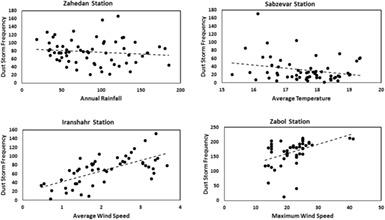当前位置:
X-MOL 学术
›
Int. J. Climatol.
›
论文详情
Our official English website, www.x-mol.net, welcomes your feedback! (Note: you will need to create a separate account there.)
Dust storm frequency change in relation to climate drivers
International Journal of Climatology ( IF 3.9 ) Pub Date : 2020-05-29 , DOI: 10.1002/joc.6675 Reza Modarres 1
International Journal of Climatology ( IF 3.9 ) Pub Date : 2020-05-29 , DOI: 10.1002/joc.6675 Reza Modarres 1
Affiliation

|
Climate variability and change in arid regions are important factors in controlling emission, frequency and movement of dust storms. This study provides robust statistical methods including univariate Mann‐Kendall block bootstrapping method and three bivariate trend assessment methods, Covariance Inversion Test, Covariance Sum Test and The Covariance Eigenvalue to detect trends in dust storm frequency across arid regions of Iran in relation to climate variability and trend in recent decades. In this regard, the annual number of dust storms from 25 stations in central arid and semi‐arid regions of Iran were selected. In addition, five major climatic variables including annual rainfall, annual maximum and average wind speed, annual maximum and average temperature were also collected. The univariate trend test indicates both increasing and decreasing trend in dust storm frequency and climate variables. The bivariate trend test shows a strong and statistically significant relationship between trend of climate variables and dust storm frequency for most of the stations across the region. Among climate variables, rainfall change has an inverse impact on dust storm frequency while wind speed and temperature have direct covariance structure with dust storm frequency. The wind speed also seems to be the most effective climate driver on dust storm frequency in arid regions of Iran, followed by temperature. The results also shows that local conditions that are not considered in this study may also play a significant role in dust storm emission in some parts of the region.
中文翻译:

沙尘暴频率变化与气候驱动因素的关系
干旱地区的气候多变性和变化是控制沙尘暴的排放,频率和移动的重要因素。这项研究提供了可靠的统计方法,包括单变量Mann-Kendall块引导法和三种双变量趋势评估方法,协方差反演测试,协方差和检验和协方差特征值,以检测伊朗干旱地区沙尘暴频率与气候易变性和最近几十年的趋势。因此,选择了伊朗中部干旱和半干旱地区25个站点的年度沙尘暴数量。此外,还收集了五个主要气候变量,包括年降雨量,年最大和平均风速,年最大和平均温度。单变量趋势检验表明沙尘暴频率和气候变量呈上升和下降趋势。双变量趋势检验表明,该地区大多数站点的气候变量趋势与沙尘暴发生频率之间具有很强的统计学意义。在气候变量中,降雨变化对沙尘暴频率具有相反的影响,而风速和温度与沙尘暴频率具有直接的协方差结构。风速似乎也是伊朗干旱地区沙尘暴频率最有效的气候驱动因素,其次是温度。结果还表明,本研究未考虑的当地条件在该地区某些地区的沙尘暴排放中也可能起重要作用。双变量趋势检验表明,该地区大多数站点的气候变量趋势与沙尘暴发生频率之间具有很强的统计学意义。在气候变量中,降雨变化对沙尘暴频率具有相反的影响,而风速和温度与沙尘暴频率具有直接的协方差结构。风速似乎也是伊朗干旱地区沙尘暴频率最有效的气候驱动因素,其次是温度。结果还表明,本研究未考虑的当地条件在该地区某些地区的沙尘暴排放中也可能起重要作用。双变量趋势检验表明,该地区大多数站点的气候变量趋势与沙尘暴发生频率之间具有很强的统计学意义。在气候变量中,降雨变化对沙尘暴频率具有相反的影响,而风速和温度与沙尘暴频率具有直接的协方差结构。风速似乎也是伊朗干旱地区沙尘暴频率最有效的气候驱动因素,其次是温度。结果还表明,本研究未考虑的当地条件在该地区某些地区的沙尘暴排放中也可能起重要作用。在气候变量中,降雨变化对沙尘暴频率具有相反的影响,而风速和温度与沙尘暴频率具有直接的协方差结构。风速似乎也是伊朗干旱地区沙尘暴频率最有效的气候驱动因素,其次是温度。结果还表明,本研究未考虑的当地条件在该地区某些地区的沙尘暴排放中也可能起重要作用。在气候变量中,降雨变化对沙尘暴频率具有相反的影响,而风速和温度与沙尘暴频率具有直接的协方差结构。风速似乎也是伊朗干旱地区沙尘暴频率最有效的气候驱动因素,其次是温度。结果还表明,本研究未考虑的当地条件也可能在该地区某些地区的沙尘暴排放中起重要作用。
更新日期:2020-05-29
中文翻译:

沙尘暴频率变化与气候驱动因素的关系
干旱地区的气候多变性和变化是控制沙尘暴的排放,频率和移动的重要因素。这项研究提供了可靠的统计方法,包括单变量Mann-Kendall块引导法和三种双变量趋势评估方法,协方差反演测试,协方差和检验和协方差特征值,以检测伊朗干旱地区沙尘暴频率与气候易变性和最近几十年的趋势。因此,选择了伊朗中部干旱和半干旱地区25个站点的年度沙尘暴数量。此外,还收集了五个主要气候变量,包括年降雨量,年最大和平均风速,年最大和平均温度。单变量趋势检验表明沙尘暴频率和气候变量呈上升和下降趋势。双变量趋势检验表明,该地区大多数站点的气候变量趋势与沙尘暴发生频率之间具有很强的统计学意义。在气候变量中,降雨变化对沙尘暴频率具有相反的影响,而风速和温度与沙尘暴频率具有直接的协方差结构。风速似乎也是伊朗干旱地区沙尘暴频率最有效的气候驱动因素,其次是温度。结果还表明,本研究未考虑的当地条件在该地区某些地区的沙尘暴排放中也可能起重要作用。双变量趋势检验表明,该地区大多数站点的气候变量趋势与沙尘暴发生频率之间具有很强的统计学意义。在气候变量中,降雨变化对沙尘暴频率具有相反的影响,而风速和温度与沙尘暴频率具有直接的协方差结构。风速似乎也是伊朗干旱地区沙尘暴频率最有效的气候驱动因素,其次是温度。结果还表明,本研究未考虑的当地条件在该地区某些地区的沙尘暴排放中也可能起重要作用。双变量趋势检验表明,该地区大多数站点的气候变量趋势与沙尘暴发生频率之间具有很强的统计学意义。在气候变量中,降雨变化对沙尘暴频率具有相反的影响,而风速和温度与沙尘暴频率具有直接的协方差结构。风速似乎也是伊朗干旱地区沙尘暴频率最有效的气候驱动因素,其次是温度。结果还表明,本研究未考虑的当地条件在该地区某些地区的沙尘暴排放中也可能起重要作用。在气候变量中,降雨变化对沙尘暴频率具有相反的影响,而风速和温度与沙尘暴频率具有直接的协方差结构。风速似乎也是伊朗干旱地区沙尘暴频率最有效的气候驱动因素,其次是温度。结果还表明,本研究未考虑的当地条件在该地区某些地区的沙尘暴排放中也可能起重要作用。在气候变量中,降雨变化对沙尘暴频率具有相反的影响,而风速和温度与沙尘暴频率具有直接的协方差结构。风速似乎也是伊朗干旱地区沙尘暴频率最有效的气候驱动因素,其次是温度。结果还表明,本研究未考虑的当地条件也可能在该地区某些地区的沙尘暴排放中起重要作用。


























 京公网安备 11010802027423号
京公网安备 11010802027423号